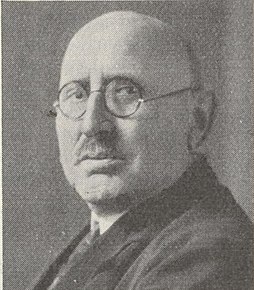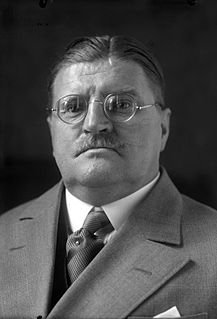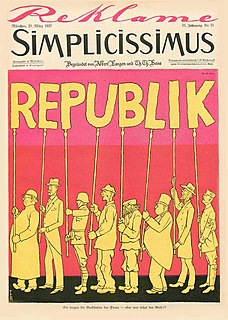The Reichskunstwart (German: Imperial Art Protector) was an official position within the Ministry of the Interior of the Weimar Republic, which was concerned with artistic matters and other regulatory issues. It mediated between regulators and artists. Its official address was Berlin NW 40, Platz der Republik 6. [1] The role also covered monitoring the aesthetic quality of the new currency, lags, stamps and other such emblematic creations of the Weimar state. [2] :86

German is a West Germanic language that is mainly spoken in Central Europe. It is the most widely spoken and official or co-official language in Germany, Austria, Switzerland, South Tyrol (Italy), the German-speaking Community of Belgium, and Liechtenstein. It is also one of the three official languages of Luxembourg and a co-official language in the Opole Voivodeship in Poland. The languages which are most similar to German are the other members of the West Germanic language branch: Afrikaans, Dutch, English, the Frisian languages, Low German/Low Saxon, Luxembourgish, and Yiddish. There are also strong similarities in vocabulary with Danish, Norwegian and Swedish, although those belong to the North Germanic group. German is the second most widely spoken Germanic language, after English.

The Weimar Republic is an unofficial historical designation for the German state from 1918 to 1933. The name derives from the city of Weimar, where its constitutional assembly first took place. The official name of the republic remained Deutsches Reich unchanged from 1871, because of the German tradition of substates. Although commonly translated as "German Empire", the word Reich here better translates as "realm", in that the term does not have monarchical connotations in itself. The Reich was changed from a constitutional monarchy into a republic. In English, the country was usually known simply as Germany.
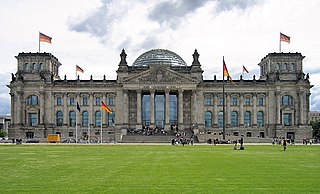
Platz der Republik is a square in Berlin, Germany. It is located in the Tiergarten, directly in front (west) of the Reichstag building. The square has an area of about 36,900 square meters and is almost completely covered by grass but is decorated with some hedges and a few trees.
When the post was announced, a number of people were suggested including Ernst Grisebach, Wilhelm Worringer, Wilhelm Valentiner. [2] However on 29 December 1919, Edwin Redslob was appointed to the post. [3] His investiture occurred on 1 July 1920. [4] On 27 February 1933, the new Minister of the Interior, Wilhelm Frick, ordered the immediate dismissal of Redslob. [5] The duties of the position were transferred to the Reich Ministry of Public Enlightenment and Propaganda. [6]
Wilhelm Robert Worringer was a German art historian known for his theories about abstract art and its relation to avant-garde movements such as German Expressionism. Through his influence on the art critic T. E. Hulme, his ideas were influential in the development of early British modernism, especially Vorticism.
Wilhelm Reinhold Valentiner was a German art historian, art critic and museum official.
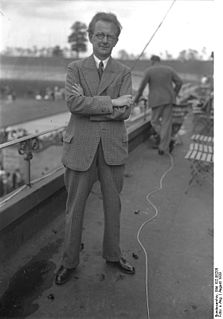
Edwin Redslob was the Reichskunstwart under the Weimar Republic. Appointed in 1920, he was the only person to fulfil this role as the position was abolished following the Nazi seizure of power in 1933.


